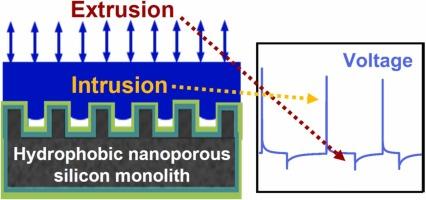疏水纳米多孔硅整体中非润湿液体侵入-挤压过程中的摩擦电作用
IF 17.1
1区 材料科学
Q1 CHEMISTRY, PHYSICAL
引用次数: 0
摘要
摩擦电纳米发电机(TENGs)是一种通过接触通电和静电感应将机械能转化为电能的有前途的装置。然而,与瞬时功率、电流和电压不同,所产生的能量在目前充满活力的teng研究领域中很少得到解决。在这项研究中,我们研究了基于纳米多孔硅单体和非润湿液体(即水和1 mg/mL聚乙烯亚胺溶液)的侵入-挤压摩擦电纳米发电机(ie - teng),研究了该过程中产生的能量、转换效率以及所观察到的现象背后的机制。与基于粉末的ie - teng相比,单片硅结构的使用能够更有效和可重复地收集能量,在瞬时功率密度和每循环能量方面都有显着改善。我们还分析了压缩率和液体性质对电输出的影响,结果表明,更高的压缩率提高了发电量,而改变液体介质显著提高了转换效率,最高可达9%。此外,通过计算分析,我们确定了接枝缺陷对产生的摩擦电输出的关键作用。这项工作通过实现单片纳米孔结构,介绍了一种新的摩擦电能量收集方法,并提供了一种通过受限固液界面增强接触电气化的替代途径。这些发现为多孔系统的摩擦电行为提供了新的见解,并为下一代高性能ie - teng铺平了道路,在可穿戴电子产品、环境能量收集和自供电传感系统中具有潜在的应用前景。本文章由计算机程序翻译,如有差异,请以英文原文为准。

Triboelectrification during non-wetting liquids intrusion–extrusion in hydrophobic nanoporous silicon monoliths
Triboelectric nanogenerators (TENGs) have emerged as promising devices for converting mechanical energy into electrical energy through contact electrification and electrostatic induction. However, the generated energy, unlike instantaneous power, current and voltage, is rarely addressed in the vibrant research field of TENGs. In this study, we investigate Intrusion–Extrusion Triboelectric Nanogenerators (IE-TENGs) based on nanoporous silicon monoliths and non-wetting liquids (i.e., water and a 1 mg/mL polyethylenimine solution), addressing the energy generated during this process, conversion efficiency as well as the mechanism underlying the observed phenomena. Compared to powder-based IE-TENGs, the use of monolithic silicon structures enables more efficient and reproducible energy harvesting, with significant improvements in both instantaneous power density and energy per cycle. We also analyzed the impact of compression rate and liquid properties on electrical output, showing that higher compression rates improve power generation, while modifying the liquid medium significantly improves conversion efficiency, reaching up to 9 %. Furthermore, through computational analysis, we identify the crucial role of grafting defects on the generated triboelectric output. This work introduces a novel approach to triboelectric energy harvesting by implementing a monolithic nanoporous architecture and offering an alternative pathway for enhancing contact electrification via confined solid–liquid interfaces. These findings provide new insights into the triboelectric behavior of porous systems and pave the way for next-generation high-performance IE-TENGs, with potential applications in wearable electronics, environmental energy harvesting, and self-powered sensing systems.
求助全文
通过发布文献求助,成功后即可免费获取论文全文。
去求助
来源期刊

Nano Energy
CHEMISTRY, PHYSICAL-NANOSCIENCE & NANOTECHNOLOGY
CiteScore
30.30
自引率
7.40%
发文量
1207
审稿时长
23 days
期刊介绍:
Nano Energy is a multidisciplinary, rapid-publication forum of original peer-reviewed contributions on the science and engineering of nanomaterials and nanodevices used in all forms of energy harvesting, conversion, storage, utilization and policy. Through its mixture of articles, reviews, communications, research news, and information on key developments, Nano Energy provides a comprehensive coverage of this exciting and dynamic field which joins nanoscience and nanotechnology with energy science. The journal is relevant to all those who are interested in nanomaterials solutions to the energy problem.
Nano Energy publishes original experimental and theoretical research on all aspects of energy-related research which utilizes nanomaterials and nanotechnology. Manuscripts of four types are considered: review articles which inform readers of the latest research and advances in energy science; rapid communications which feature exciting research breakthroughs in the field; full-length articles which report comprehensive research developments; and news and opinions which comment on topical issues or express views on the developments in related fields.
 求助内容:
求助内容: 应助结果提醒方式:
应助结果提醒方式:


